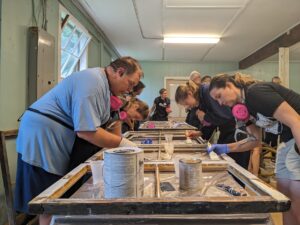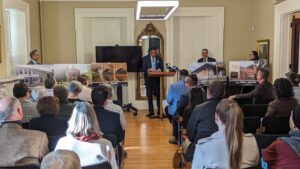
Project Profile: A Portico, Expertly Restored
- May 19, 2022
- 1:19 pm
- May 19, 2022
- 1:19 pm
As part of our Spring 2022 “Traditional Trades” issue of Landmarks magazine, we highlighted a project undertaken by architect and Landmark Society member Dave Beinetti. This 1830s Greek Revival home in Honeoye Falls has been a labor of love and a lesson in the unexpected. We visited Beinetti at his home last November, and talked to him about his most recent project, the restoration and partial reconstruction of the home’s portico.
Dave Beinetti, architect and Chief Marketing Officer for SWBR, and his wife Joan are no strangers to historic homes. Before purchasing their current house in Honeoye Falls, they owned two different 1920s-era homes in Rochester’s 19th Ward. Dave describes them as “classic city houses,” the first of which required more rehabilitation than the second.
In 2000, the couple purchased an old farmhouse on Plains Road in Mendon, and wasted no time in getting to work. For the next several months, they tackled necessary repairs and interior projects. One of the first things they did was tear out a “clipped chimney” that rested on a beam, rather than going down to the foundation. The beam that supported the chimney was attached by rods to a beam in an exterior wall, and over time, the weight of the chimney had begun to “twist” the house. They also removed acoustic ceiling panels in the dining room and used a corn cob blasting technique to clean the re-exposed post and beam construction. Several walls and sections of rotten flooring were removed from the kitchen and dining area. Dave recalls eating at a picnic bench while constructing the new kitchen and installing new power, drywall, and lighting.
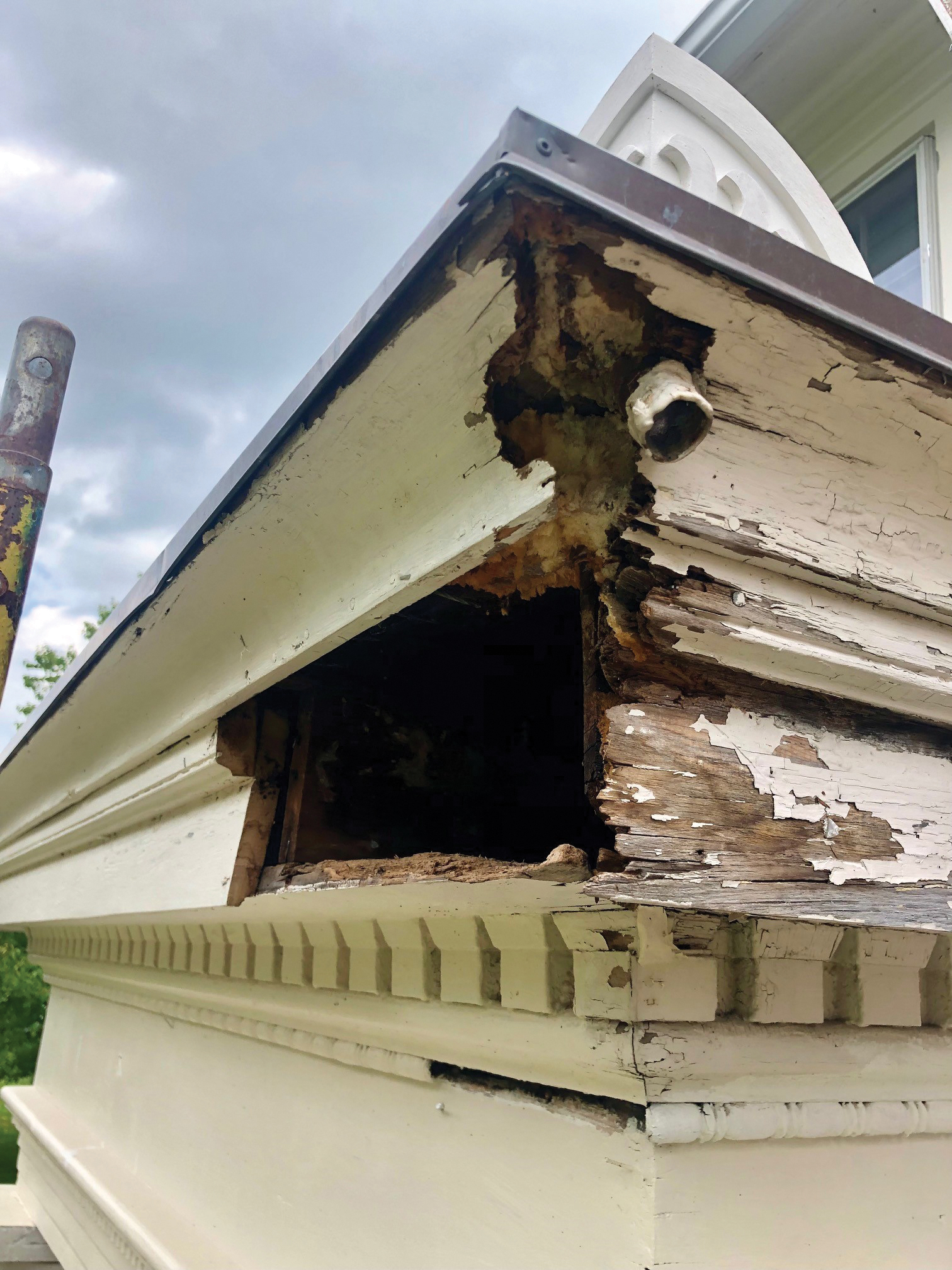
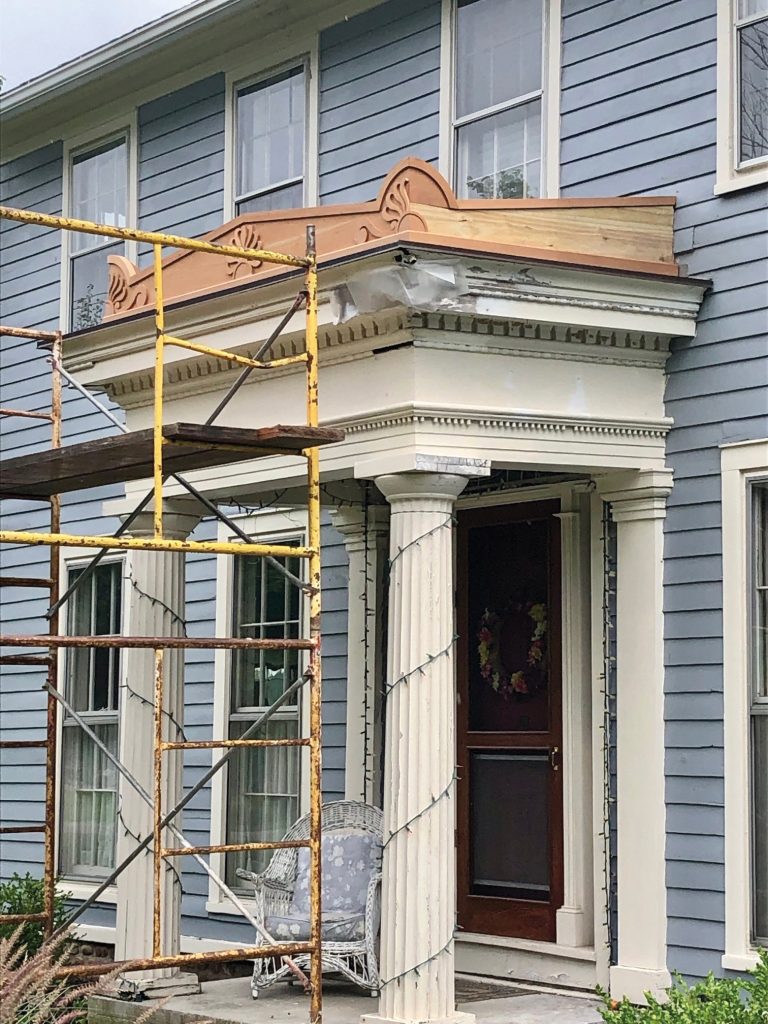
It took four to five months of essential repairs before the family was able to move in, and eventually the house became, in Dave’s words,”less of a project and more of a hobby.” It wasn’t until 2021 that he made his way to the portico on the front of the house. Most of the issues there were due to poor moisture management. The original roof hadn’t been maintained, so water had penetrated the framing and downspout, causing significant rot at the corners. Fortunately the rest of the old-growth framing was more rot-resistant and therefore in good condition; so the portico was able to be repaired, rather than completely rebuilt.
Dave emphasized how crucial the input of skilled tradespeople was when approaching this complicated rehabilitation. He told us that he wouldn’t have had the guts to go into the project without expert advice. He also credits Mendon Town Historian and neighbor Diane Ham, and now-retired Landmark Society Architectural Research Coordinator Cynthia Howk. Diane provided a wealth of historic information about the house, including the assertation that the portico was probably not original. She believes that the original entrance would have been much simpler, and that a farmer would have been unlikely to spend money on something so ornate.
The most interesting part of the portico restoration was the replication and reconstruction of the “fence” or “crown” on top, which featured a palm motif common in Greek Revival architecture. It’s still a mystery as to when the crown was added, since it is not visible in any of the historic images Dave or Diane have been able to find. When the house was purchased in 2000, the side pieces were present, but the face piece was missing. Fortunately, the original face piece was found in the barn when the Beinettis purchased the property, and was set it aside with the intent to replicate it. Twenty years later, when he was finally able to work on the portico, Dave and his craftsmen were able to use the original to create a near-identical replica.
While confident in many other aspects of architectural restoration, Dave knew he wouldn’t be able to rebuild the top of the portico, and didn’t think other woodworkers would be interested in the project. He found a willing artist in Gian-Paul Piane, a Rochester-area architect and furniture-maker. Gian-Paul recreated the original piece and ensured that all of the pieces, new and old, aligned perfectly.
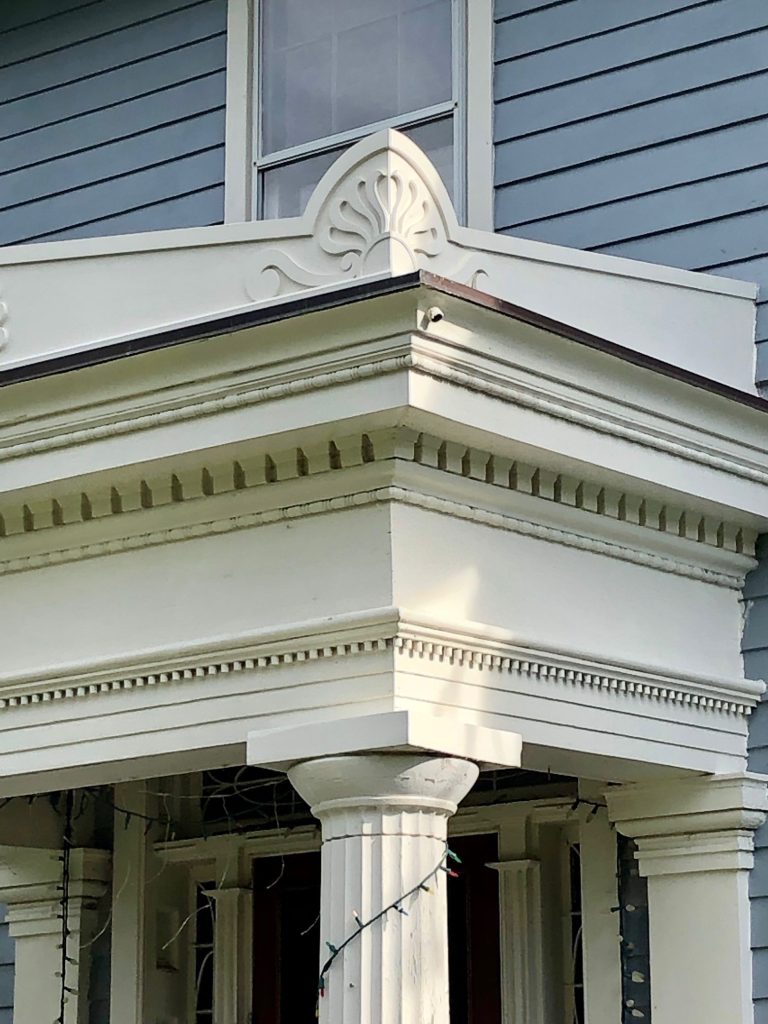
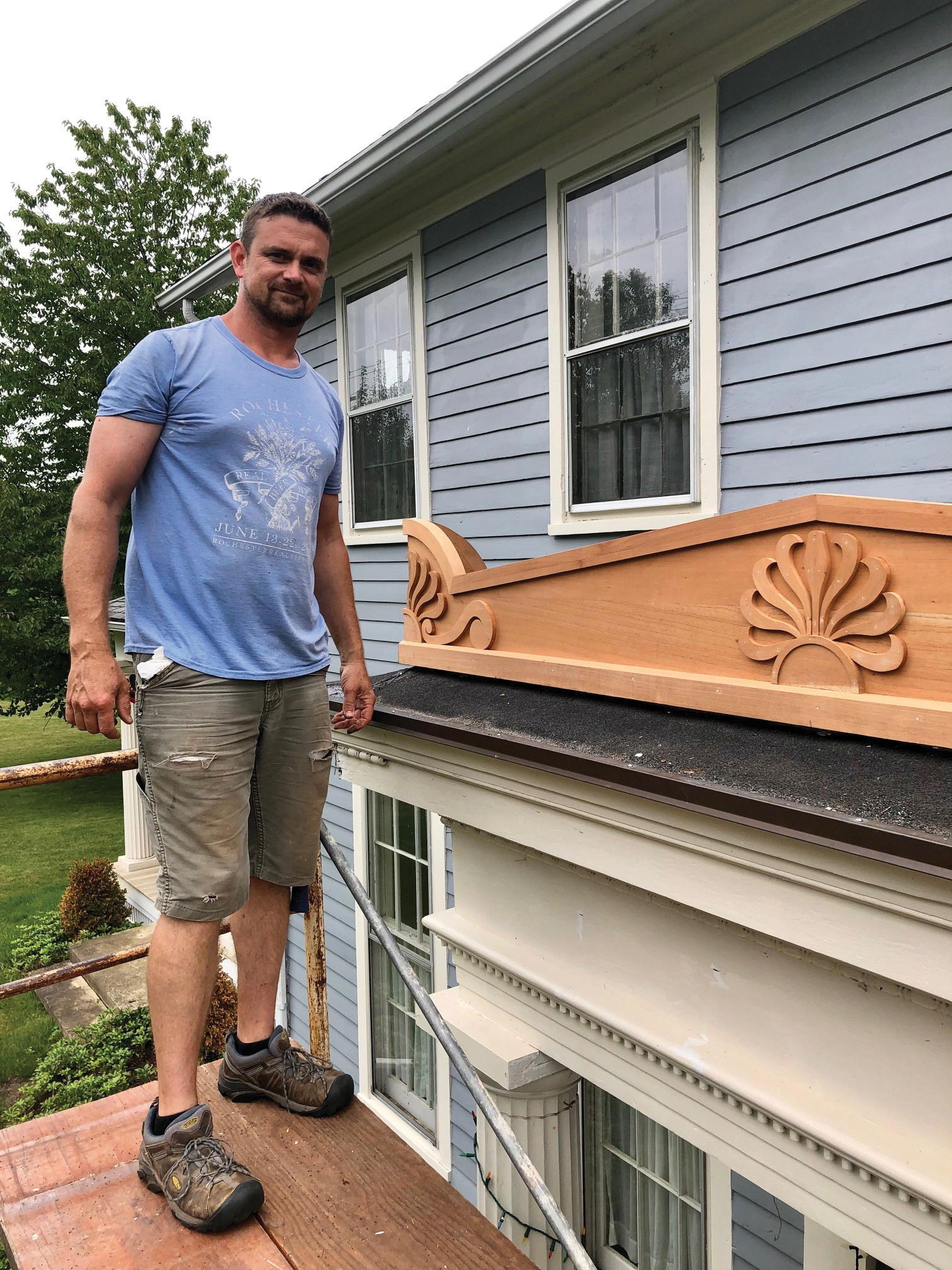
To install the rebuilt crown, Dave hired Aaron Jones, pictured below, a finish carpenter that he trusted to reassemble everything correctly. Aaron did the majority of the install and Dave assisted with some of the puttying and wood filler.
Yet another talented craftsperson was brought in to replicate the original mahogany dowels that surround the portico just below the dentils. For the final phase of the project, Dave himself restored the rotten corners and dentils, reattached the dowels, and did the final painting.
Dave had great success with ABATRON’s LiquidWood Wood Restoration Kit, which he used to reconstitute the wood fibers not only in the portico, but in other areas where the house had experienced wood rot, like window and door sills. He did all of that work himself, and then turned to Scott Grove of ImagineGrove Woodworking for advice on using wood filler to complete the project.
Dave is very happy with how the portico restoration turned out, and knows that without the expertise of contractors and mentors, he may not have had such a successful result.
So what’s next?
The farm house is part of a much larger property that includes a barn and several outbuildings. The barn roof is in need of replacing; a costly endeavor, but the homeowners are committed to preserving it. There are also ongoing cosmetic projects in the interior including a new tile floor in the upstairs bathroom and upgrades to the kitchen. The wooden floors on the first floor will be lightly sanded and recoated to hopefully last another twenty years. Dave made sure to emphasize the importance of preservation, and how the desire to preserve his home has helped him overcome moments of just wanting to give up (did we mention the termites?) His advice to others facing large restoration projects is to take your time, but to be willing to put in the time. A priority list is essential: stabilize what needs to be stabilized and make the place enjoyable to live in before tackling the less critical issues. And finally, be willing to bring in experts when you need them.
All images courtesy of Dave Beinetti.
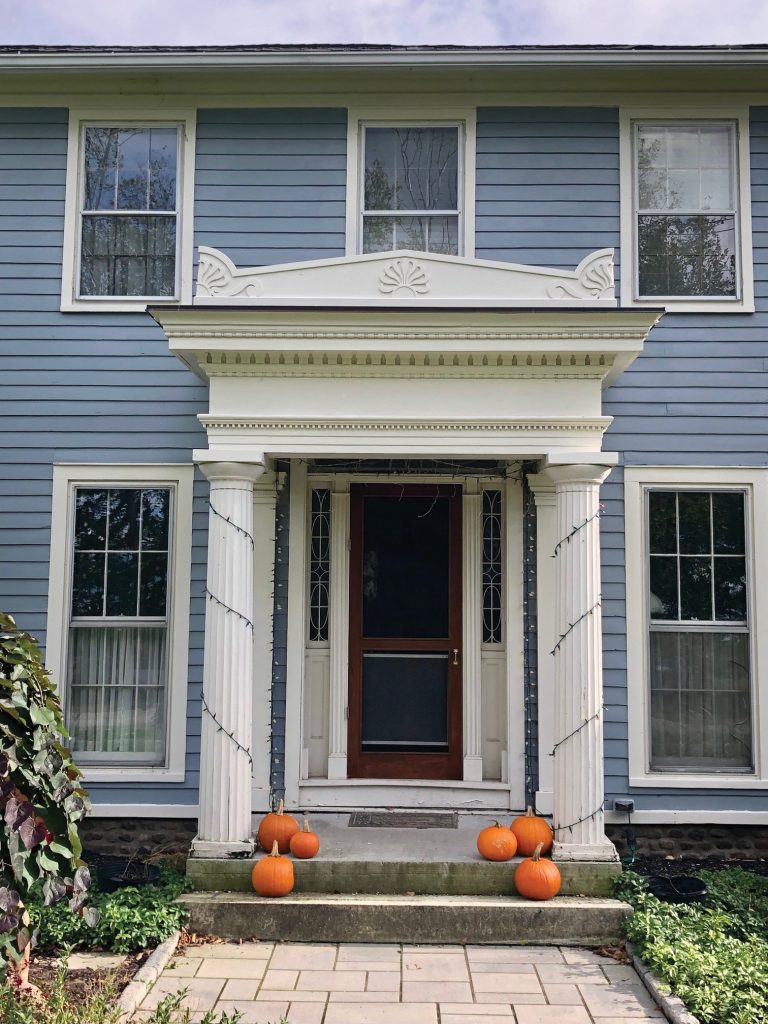
We asked Dave Beinetti how he found the skilled tradespeople that helped him with this complicated project, and (not to toot our own horn!) he told us he called The Landmark Society! Did you know that we maintain a list of experts in all fields of historic restoration, and can help direct folks to a craftsperson that best suits their needs? Click here for more information. You can learn more about the Traditional Trades in our Spring 2022 issue of Landmarks Magazine.
SHARE


